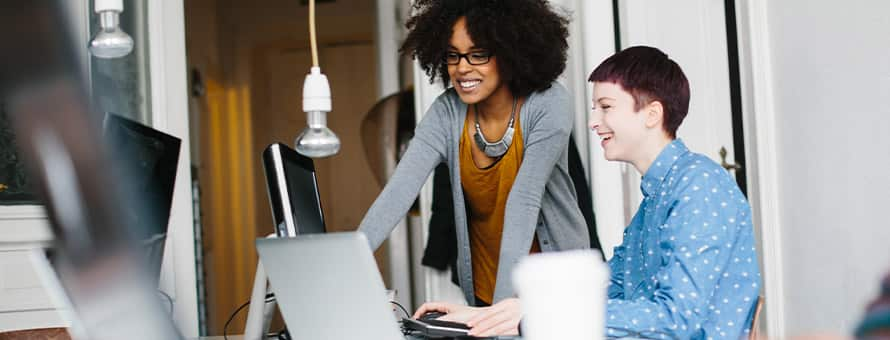How to Become a Web Designer

Understanding the numbers
When reviewing job growth and salary information, it’s important to remember that actual numbers can vary due to many different factors—like years of experience in the role, industry of employment, geographic location, worker skill and economic conditions. Cited projections are based on Bureau of Labor Statistics data, not on SNHU graduate outcomes, and do not guarantee actual salary or job growth.
If you’re looking for the perfect marriage of your creativity and affinity for problem-solving, a career in web design could be the answer.
Knowing how to build a website on the user-facing side, as well as being familiar with how the backend is programmed, can make you a valuable asset at a standalone marketing agency, in the development department of a large corporation or may enable you to set up your own web design firm.
But how do you gain the technical knowledge and soft skills web designers need? And how do you best position yourself for your first job in the field?
Education, real-world application and networking can all help.
How Can I Get Into Web Design with No Experience?
No experience? No problem. Try some of the following approaches to better position yourself for a web designer role.
Education
Studying web design not only introduces you to the knowledge and skills necessary for a successful career, but it can also help you gain relevant experiences and develop portfolio pieces through projects.
A college degree or a certificate are two types of education you could consider.
College Degree
If you'd like to add a four-year degree to your resume, you might research bachelor's degrees in graphic design or information technology (IT):
- Graphic Design Degree: Learn how you can bring visual ideas to life in courses that discuss design thinking, digital design tools, user interface and more. Some schools may also offer concentrations in web design and user experience, allowing you to dive deeper into the digital applications of graphic design.
- IT Degree: Gain foundations across a variety of technical areas, such as in computer operating systems, databases and networks, to help you understand how communication, collaboration and problem-solving are key in this ever-changing field. There may also be courses that help you keep the user front of mind.
If you already have a bachelor's degree in a different subject but are planning to change your career to web design, you might consider a master's degree.
A master's in information technology with a concentration in web design can help you learn how to design functional websites that consider user experience, demographics and other relevant data.
Apply Your Learnings
Regardless of the program you choose to pursue, it’s ideal if you can obtain real-world experience to supplement what you're learning in the classroom.
“You can test out (the field) and build networking via internships. It can even turn into a job,” said Faryal Humkar, a STEM career advisor at SNHU.
Find a Mentor
Keep an eye out for a mentor. It could be an instructor, alumni or classmates already in the industry.
“Finding a mentor is probably one of the best ways to master your career,” Humkar said. “Someone to show you the ropes, what they did right and wrong themselves, and guide you with sound advice.”
Professional organizations like AIGA and networking via LinkedIn are also great ideas.
How Many Years Does it Take to Learn Web Design?
The time it takes to learn web design can vary and depend on the type of program you choose to pursue. A user experience certificate, for instance, can be completed in nine months.
On the other hand, a bachelor's degree typically takes four years, although it could take less time with the help of shorter online terms, transfer credits, military experiences, certifications and more. Find out how to get a bachelor's degree faster.
There's no standard educational requirement for web designers, also known as digital designers, according to the U.S. Bureau of Labor Statistics (BLS). Some job listings may accept candidates with a high school diploma as the minimum educational qualification if they can showcase web design abilities. Other listings call for a college degree in a relevant field.
What Skills Do Web Designers Need?
To maximize their knowledge and technical know-how, web designers need a range of skills. Here are five skills SNHU staff and instructors believe to be the most important for success in web design.
 1. Ability to Take Criticism
1. Ability to Take Criticism
You need to be able to separate yourself from your creation and not take edits and feedback personally.
“Be able to separate yourself from your work; someone is trying to help you, to learn and grow,” said Peter Spooner, assistant vice president of web development at SNHU. “You can really accomplish more without those roadblocks of taking things personally. Welcome feedback in any career.”
2. Attention to Detail
There are many T's to cross and I's to dot in making a successful website and UX. You should enjoy that process. “You’ll need to be a problem-solver who enjoys that a-ha moment,” said Jason Proske '15, an adjunct instructor in SNHU's master's in IT program with a concentration in web design. “You have to have that interest in finding that needle in a haystack.”
 Practicing this attention to detail as you work on projects in the classroom setting can help you develop persistence that translates to the workplace.
Practicing this attention to detail as you work on projects in the classroom setting can help you develop persistence that translates to the workplace.
“I can tell good future programmers and developers,” said Dian Brandenburg, an adjunct instructor of web design and database design at SNHU. “They’re problem-solvers who think outside the box, who won’t give up… ‘I know I can make it work.’” Now retired, Brandenburg has more than 25 years of experience working in and teaching web design, and she owned and ran a web design company for 15 years.
3. Communication Skills
 You’ll need to know how to communicate — with your development team and with clients inside and outside your organization. As a web designer, the more you know about programming, the better off you’ll be when communicating and working with the back-end developers.
You’ll need to know how to communicate — with your development team and with clients inside and outside your organization. As a web designer, the more you know about programming, the better off you’ll be when communicating and working with the back-end developers.
“Knowing the lingo is important,” said William Kirtley, graphic design adjunct instructor at SNHU. “A lot of what an agency does is contingent on the platforms and strategies used. Any graphic designer who will create content as well as imagery needs to know (backend) structure and functionality, the lingo developers use, and what can and can’t be done.”
4. Creative and Analytical Thinking
 Web design is where creativity and technicality unite so you can make informed decisions when designing, testing and modifying websites.
Web design is where creativity and technicality unite so you can make informed decisions when designing, testing and modifying websites.
“It’s good to be both left and right brain(ed) because it informs the design decisions you’re going to make,” said Jenna Palermo, a graphic design adjunct instructor at SNHU. “You need to think about the technical aspects and how that affects the look and feel of the design aspect.”
5. Motivated to Learn
Because every client you design for will be different, you need to enjoy the process of learning new systems and technology on the fly. “You need to be able to learn quickly on the job because each agency (and client) operates differently — naming conventions, file management systems, archiving of projects, etc.,” Kirtley said.
Staying current with developments in the industry will also be key to your ongoing value as a web designer. “Keep in touch with what’s happening in the marketplace — trends in the industry, what’s resonating with users,” Spooner said. “Adapt your style to keep it relevant (for your) personal growth.”
Are Web Designers in High Demand?
As the world relies on the internet more than ever, it’s expected that websites will continue to be vital components of doing business. BLS reports that web developers and digital designers will see a robust job market, with a growth projection of 23% from 2021 to 2031.
BLS also reports the median annual wage for web developers and digital designers was $78,300 in May 2021.
Leveraging your existing network can get you a web design job, for example, via your internships. You might also explore your company’s options if you’re already employed.
 “If you have the ability to talk to a manager, especially in IT, you can see if there is an internship opportunity to get your foot in the door,” Proske said, “and you can transition into that department instead of trying to find a completely new job.”
“If you have the ability to talk to a manager, especially in IT, you can see if there is an internship opportunity to get your foot in the door,” Proske said, “and you can transition into that department instead of trying to find a completely new job.”
It’s never too soon to start job-seeking and building your resume. “Join a club related to your career goal; link up with classmates and alumni and get advice on job searching and skills,” Humkar said. “If you’re not in the field yet, get as much experience as you can while you’re a student, before graduation. A degree plus experience in the field makes you more valuable.”
If you’re striking out on your own, or trying to build a resume early on, consider doing some gratis work. “If you haven’t done any websites, do some for free,” Proske said. Pro bono work can help you gain experience and samples to share with potential clients.
Is Web Design a Good Career?
Being part of a web design and development team can be very rewarding and collaborative.
“I love my job. I’ve been fortunate in my software-development career,” Spooner said. “I’ve had good relationships with UX/web designers. They provide tremendous value to the development team — having both groups looking at problem-solving, but from different points of view.”
A degree can change your life. Find the SNHU technology degree that can best help you meet your goals.
Kathleen Palmer is an award-winning journalist and writer.
Explore more content like this article

How SNHU Grad Cyndie Ramirez Built Her Second Career in Cybersecurity

California Couple Earn Cybersecurity Master’s Degree Together from SNHU

SNHU Spotlight: Gina Cramer, BS in Cybersecurity Grad
About Southern New Hampshire University

SNHU is a nonprofit, accredited university with a mission to make high-quality education more accessible and affordable for everyone.
Founded in 1932, and online since 1995, we’ve helped countless students reach their goals with flexible, career-focused programs. Our 300-acre campus in Manchester, NH is home to over 3,000 students, and we serve over 135,000 students online. Visit our about SNHU page to learn more about our mission, accreditations, leadership team, national recognitions and awards.



